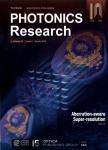Enhanced four-wave mixing process near the excitonic resonances of bulk MoS_2
Enhanced four-wave mixing process near the excitonic resonances of bulk MoS_2作者机构:Department of Physics Baylor University The Institute for Quantum Science and Engineering Texas A&M University College Station Princeton UniversityPrinceton
出 版 物:《Photonics Research》 (光子学研究(英文版))
年 卷 期:2019年第7卷第3期
页 面:251-259页
核心收录:
学科分类:0808[工学-电气工程] 0809[工学-电子科学与技术(可授工学、理学学位)] 07[理学] 0805[工学-材料科学与工程(可授工学、理学学位)] 0702[理学-物理学]
基 金:National Science Foundation(NSF)(CHE-1609608) Welch Foundation(A-1261,AA-1956-20180324,A-1547) Baylor University(Baylor) Office of Naval Research(ONR)(N00014-16-1-2578)
主 题:Two-dimensional materials excitonic resonances MoS2
摘 要:Two-dimensional materials are generating great interest due to their unique electrical and optical *** particular, transition metal dichalcogenides such as molybdenum disulfide(MoS_2) are attractive materials due to the existence of a direct band gap in the monolayer limit that can be used to enhance nonlinear optical phenomena, such as Raman spectroscopy. Here, we have investigated four-wave mixing processes in bulk MoS_2 using a multiplex coherent anti-Stokes Raman spectroscopy setup. The observed four-wave mixing signal has a resonance at approximately 680 nm, corresponding to the energy of the A excitonic transition of MoS_2. This resonance can be attributed to the increased third-order nonlinear susceptibility at wavelengths near the excitonic transition. This phenomenon could open the path to using MoS_2 as a substrate for enhancing four-wave mixing processes such as coherent anti-Stokes Raman spectroscopy.



